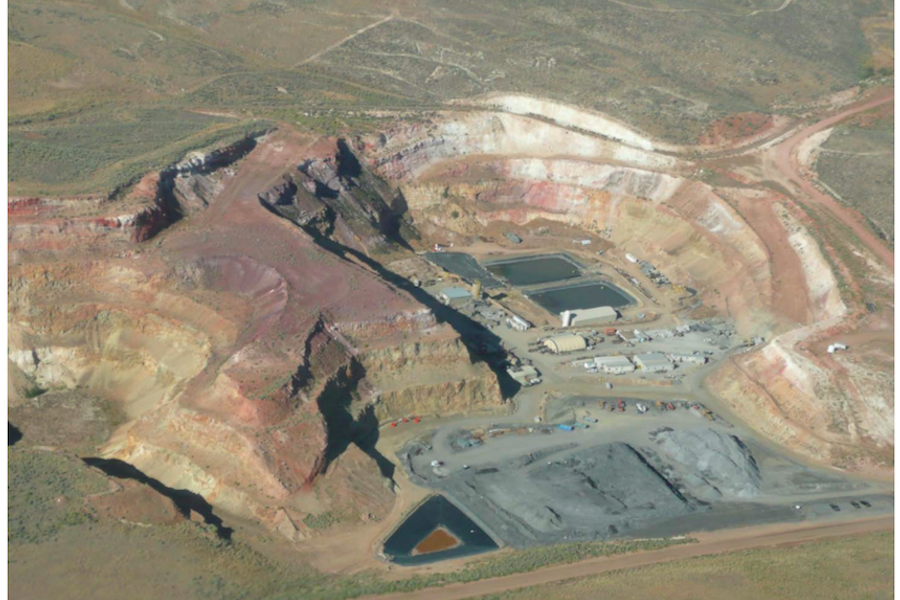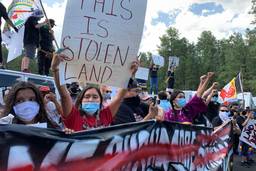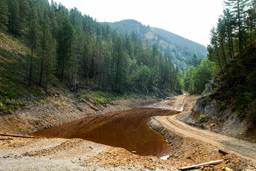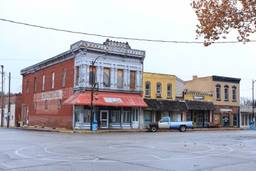Eve of Destruction: Bureau of Land Management Sacrifices Native Site to Mining Group
Stephanie Woodard

This isn’t the “new” world for the Western Shoshone. And their West was never “wild.” It is a place of deep cultural connections to a homeland that at one time extended across portions of Idaho, Nevada, Utah and California. For more than 10,000 years, they have met in what is today called the Tosawihi Quarries, a stretch of Elko County, Nevada, to gather a type of white flint and to practice their sacred rituals.
“That stone is very sacred to us,” says Joe Holley, chairman of the Battle Mountain Band of the Te-Moak Western Shoshone, one of several federally recognized, related tribes. “We use it every day and have done so for millennia, for tools, ceremonies and healing. The stone, the water, the entire place is sacred.” The word Tosawihi means White Knives, an ancestral Shoshone tribal name that ties the land and its features to their culture and identity. The Tosawihi Quarries has been deemed eligible for the National Register of Historic Places and part of it was declared an Archaeological District in 2010.
However, gold lies under the flint, also called chert, and a multinational mining group wants it.
In 2013, Nevada-based Waterton Global Mining Company, owned by a firm registered in the Cayman Islands, bought a bankrupt gold-mining operation that had been exploring for and extracting gold in the Tosawihi Quarries. In March 2014, an official at a related Canadian private-equity firm, Waterton Global Resource Management, told Reuters it had been snapping up struggling U.S. mining concerns hurt by the several-year downturn in gold prices. Reuters quoted the firm’s chief investment officer as saying, “This year I think [acquisitions] will pick up dramatically.”
By 2014, mining operations had resumed on the Shoshone’s ancestral lands, and Waterton Global Mining Company had changed its name to Carlin Resources. The new work began in previously disturbed ground and moved out from there. “A drilling pad was built in a once-pristine area,” says Holley, “and several rock shelters were demolished when they pushed through a road.” On a recent trip to the area, he saw that several ancient stone hunting blinds, from which concealed hunters observed their prey, were gone. Tribal members report that workers have videotaped them when they visit.
The band has also expressed concern to federal authorities that the mining company does not have the required groundwater monitoring well in place. “This is critical,” says Holley. “At the center of all our ceremonies is water. It is the lifeblood of the universe.”
Mining was already engulfing the sacred landscape, says the Battle Mountain Band’s attorney Rollie Wilson, who works in the Washington, D.C. office of the Omaha law firm Fredericks Peebles & Morgan. “Now matters are getting worse. With important sites damaged or destroyed, tribal members are being pushed into an ever-smaller area.” Wilson has filed an emergency appeal with the Interior Board of Land Appeals (IBLA), an Interior Department administrative court. It asks the court to suspend mining until a plan can be devised that safeguards the site.
In 1992 (on the 500th anniversary of Columbus’ first visit), protection of Native American cultural resources was added to the National Historic Preservation Act. Since then, federal agencies have been required to consult with tribes when mining, constructing dams, road building and other projects on federal land that could affect their traditional cultural properties (TCPs). These may include locations where culturally important practices occur, or occurred in the past, as well as structures.
This process is a part of the federal government’s trust relationship with the tribes, which requires the United States to protect Native treaty rights, land and other assets. In practice, tribes and their representatives regularly report that they aren’t notified early enough in the process to make a difference and when they do speak up federal officials don’t pay attention.
Holley says working with the Interior Department’s Bureau of Land Management (BLM) can be like “talking to a wall.” As the Nevada State Historic Preservation Office puts it: The BLM can operate “unilaterally.”
Some officials may have a hard time understanding a complex Native cultural landscape like the Tosawihi Quarries, which has been subtly shaped for many centuries by a range of activities including ceremonies, tool making, medicine-plant gathering and hunting. “The concept of ‘cultural landscape’ emerged in the late 1980s, which really isn’t that long ago,” says Paul Loether, Chief of the National Register of Historic Places, a National Park Service program. As a result, Loether says, most evaluators are better at assessing an historic house than a tract of land, no matter what culture, Native or non-Native, shaped it.
Carlin Resources has less patience for the process than the Battle Mountain Band would wish. In Carlin’s legal response to the band’s attempt to temporarily halt drilling, the mining company said their IBLA appeal was based on “erroneous and sensationalistic assertions” that “the entire Tosawihi Quarries constitutes a TCP.” Carlin, in its brief, told the court that it had complied with all obligations and that the band’s ongoing objections had already caused it to run up substantial additional costs.
Because the Tosawihi Quarries are on federal land administered by the BLM, that agency handled the area’s TCP evaluation. Earlier mining had already taken a big chunk out of the Shoshone landscape, but Holley’s band hoped it could work with the BLM to prevent further destruction. “We were hoping to keep the mining out of what’s left of our most important areas,” Holley says.
To study and protect a landscape, archaeology is often the discipline of choice. At Tosawihi Quarries, the BLM focused on items of archaeological interest that might be saved — including what it termed “loci,” with a certain number of artifacts, such as stone tools, per square meter. The agency marked the items on maps, drew lines around them and told the mining company to stay at least 250 feet away.
“Archaeology is a great field,” says Loether. “But unfortunately, used that way, the result is like seeing the Mona Lisa’s smile, but not the rest of the painting. You can’t understand its beauty and meaning without considering the entire thing.”
“Mainstream science looks at sites differently from Indian people, who see the spiritual significance,” says Ted Howard, cultural resources director and member of the Shoshone-Paiute Tribes.
With about 500 enrolled members and a 683-acre reservation that has “little economic activity,” according to its website, the tiny Battle Mountain Band has set itself a gargantuan task. “I grew up in this fight,” says Holley. “My grandfather, father and uncle all fought mining in the Tosawihi Quarries. I’ve lived my whole life hearing them talk about this.”
“Chairman Holley and the Battle Mountain Band have taken the lead in this struggle,” says Howard. “However, many of the Shoshone people came from or used that area. Now we are separated on different reservations, but that is not how we lived before the reservation era. Our shared oral history goes way back. And the Tosawihi Quarries are the center of our spiritual being.”

The sun rises over the Tosawihi Quarries. (Photo courtesy of Joe Holley, Chairman of the Battle Mountian Band of the Te-Moak Tribe of Western Shoshone)
‘Smoking gun’ at the BLM
Sometimes, lack of understanding isn’t the only problem at a federal agency. Other interests can weigh heavily. In spring 2014, the BLM’s analysis of the mine project was still under review. It had yet to issue its final approval, or Record of Decision (ROD).
But then the mining company needed the gold — and fast.
According to public documents obtained by Rural America In These Times, Waterton contacted the BLM on Friday, March 28, 2014. It wanted the agency to issue the Record of Decision by the following Monday, March 31. A BLM official, Steph Connolly, the acting-senior special assistant to the director, notified colleagues of this request with an email headed “URGENT.”
Thomas Schmidt, a BLM geologist in a Nevada field office, replied, “I do not believe we have completely satisfied Tribe concerns.”
Another BLM geologist, Janice Stadelman, chimed in, warning against delay. “I received a call from Waterton’s legal counsel,” she emailed. “They are requesting that the ROD and approval be signed or dated no later than March 31 [2014]. March 31 is the end (last day) of the first quarter. … Waterton’s concern is with the first quarter auditing and financial reporting to there [sic] investors and the ramifications that they will encounter.”
By March 31, the ROD was signed, sealed and delivered. Thanks to the BLM rushing it through, the mining group had its gold and the window-dressing for its quarterly report. In May, Waterton issued a press release announcing a “significant permitting milestone” for the mine.
In response to a query from Rural America In These Times, BLM spokesperson Jeff Krauss described the permitting process as “robust” and “not hurried,” with full consideration under the law for the Battle Mountain Band’s concerns. He added the agency would continue to work with the band going forward. Further, according to Krauss, the BLM would require the mine’s operator to “implement sufficient monitoring and mitigation strategies in order to prevent unnecessary or undue degradation of the lands” and its sacred sites.
Looking and listening
Educating officials, legislators and the public about responsible protection of our nation’s shared legacy is an “uphill battle,” says Rebecca Knuffke, public lands project manager for the National Trust for Historic Preservation, a nonprofit chartered by Congress to safeguard our shared heritage places. Building awareness for a given site can help protect it, she says, pointing to the Trust’s National Treasures program, which describes campaigns to save places that are important to varied and sometimes multiple cultures.
In the case of a Native landscape, public awareness is handled very carefully, adds Denise Ryan, public lands policy director at the Trust. Such places may include vision sites, sacred springs, medicine-gathering areas and other geographic features that tribes consider private or secret. Like the Tosawihi hunting blinds and rock shelters, these fragile features can also be destroyed by vandals or inadvertently trampled by hikers. “In a protection plan, tribes don’t have to give us details. They just tell us what’s significant and what they require,” says Ryan.
Holley wants a complete review of the Tosawihi Quarries that accounts for subtleties that aren’t apparent to outsiders. “We Shoshone are the only ones who can say where these important things are,” Holley says. “Tosawihi is not a ‘prehistoric’ place, used only by long-ago people. We Shoshone have used all of it continuously for cultural and spiritual purposes since time immemorial.”
Meanwhile, gold mining operations continue.
Holley laments, “All those years of struggle, and we’re still losing ground.”
Editor’s note:
Since publication of Eve of Destruction, the Battle Mountain Band of the Te-Moak Western Shoshone has continued to try and protect its sacred site from destruction by gold mining. In September 2015, an Interior Department administrative court turned down the Band’s request to suspend mining until a way could be found to safeguard traditional cultural properties more effectively.
The Band then turned to the influential Advisory Council on Historic Preservation (ACHP), which is named as the final arbiter of disputes under the so-called Programmatic Agreement issued by the Bureau of Land Management (BLM) to govern mining activities. In December, ACHP issued a cautious decision that encouraged BLM to “clarify” the agreement.
“The Programmatic Agreement doesn’t need to be clarified, it needs to be implemented,” said Band attorney Rollie Wilson, of Fredericks Peebles & Morgan. “The document, signed by ACHP, requires ongoing evaluation of specific areas as mining exploration is considered. BLM is not doing that. It is relying on old and generalized surveys of the entire area, which makes no sense. The document and the law require current evaluations for project-specific proposals.”
BLM spokesperson Jeff Krauss has disagreed, saying that consultation with the Band is ongoing.
Stephanie Woodard is an award-winning human-rights reporter and author of American Apartheid: The Native American Struggle for Self-Determination and Inclusion.








